Key takeaways:
- Event follow-up is essential for building long-term relationships, reigniting enthusiasm, and gathering valuable feedback.
- Effective follow-up strategies include timely outreach, personalization, and leveraging multiple communication channels, like email and social media.
- Analyzing the effectiveness of follow-ups through engagement metrics and sentiment helps refine future strategies and strengthen connections.
- Consistent communication and personal touches, such as newsletters and handwritten notes, foster loyalty and make attendees feel valued.
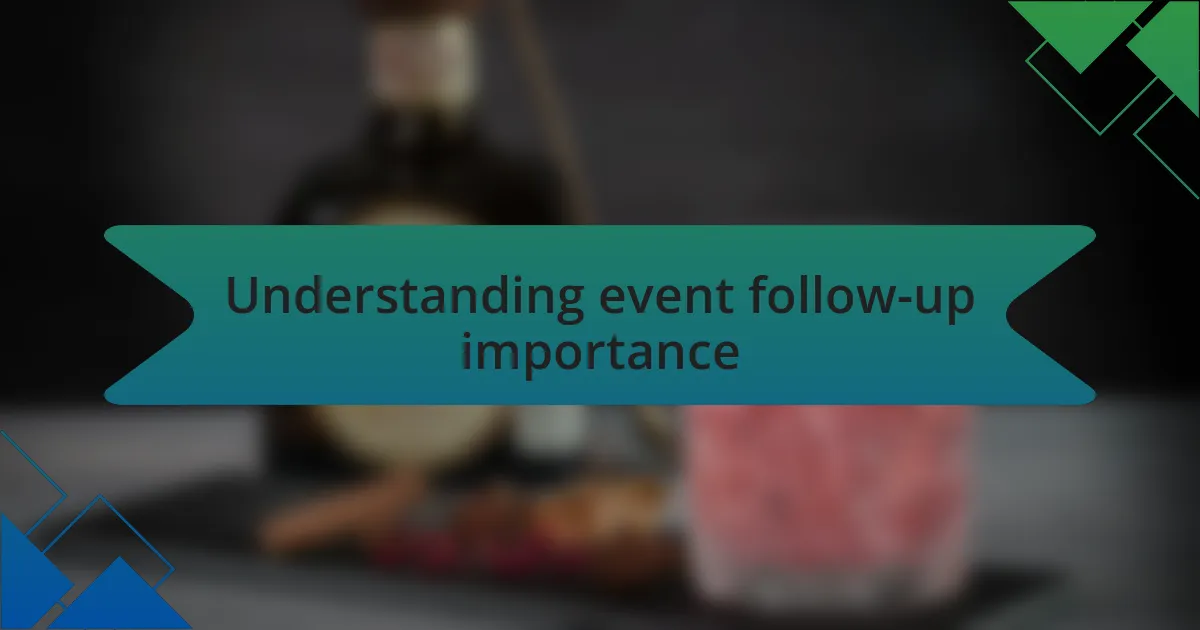
Understanding event follow-up importance
Event follow-up is crucial because it often determines the long-term impact of your efforts. I remember attending a gin tasting event a few years back, where I received a personal thank-you email from one of the distillers. That simple gesture made me feel appreciated and more connected to the brand, illustrating how follow-up can foster loyalty.
Consider this: how many times have you left an event feeling inspired, only to lose that spark a few days later? A thoughtful follow-up can reignite that enthusiasm and keep your audience engaged. It’s an opportunity not just to maintain connections, but to deepen them, transforming fleeting encounters into lasting relationships.
Moreover, following up enables you to gather feedback, which is invaluable. I once sent a quick survey after a networking event, and the insights helped shape my future events significantly. It’s not just about staying on someone’s radar—it’s about understanding their experience and enhancing your offerings for next time.
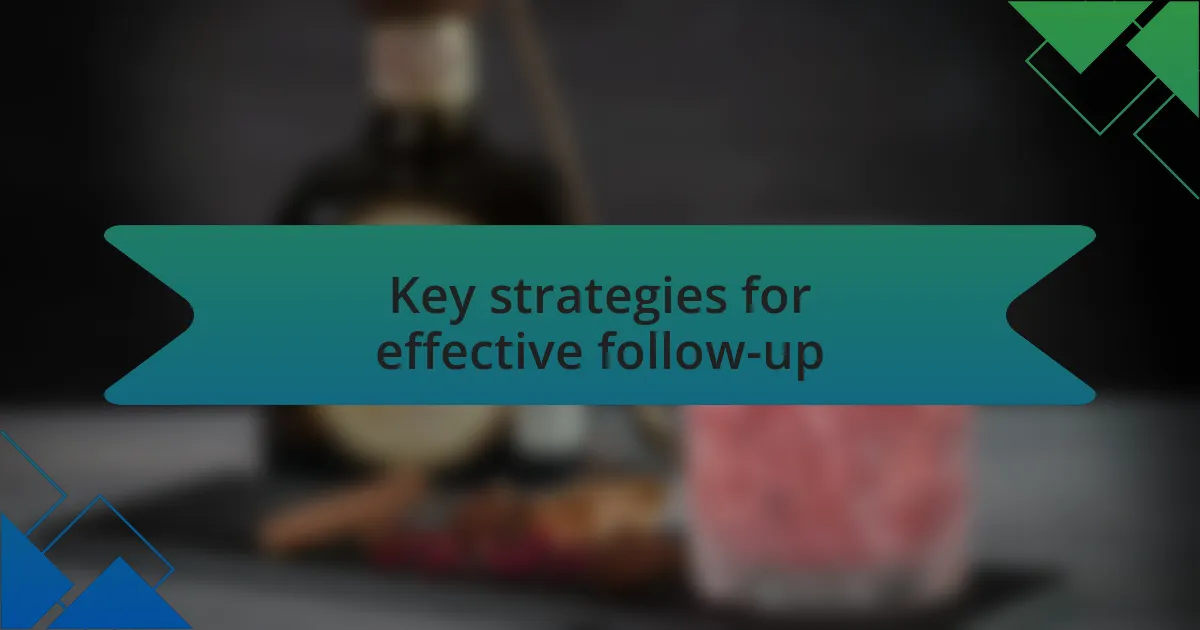
Key strategies for effective follow-up
One of the most effective strategies for follow-up is timing. I’ve found that reaching out within a few days after an event maximizes the impact of your message. It’s fresh in everyone’s mind, and I remember once sending a personalized note within 48 hours of a gin festival; the responses were overwhelmingly positive. It made people feel valued, proving that promptness shows your genuine interest in nurturing the relationship.
Another key approach is personalization. Instead of sending generic emails, I often reference a specific conversation or shared experience from the event. For instance, after a workshop, I sent tailored messages to attendees mentioning their favorite gin of the night. This thoughtful touch not only made my communication stand out but also created a sense of community and investment among participants. Don’t you think that small details can make a big difference in how people perceive your brand?
Lastly, consider leveraging multiple channels for follow-up. I’ve found that combining email with social media outreach can amplify your message. After an event, I often share snippets on platforms like Instagram, linking back to more in-depth content in my emails. This multi-channel strategy not only keeps your audience engaged but also allows them to interact with your brand in various ways, enhancing the overall experience. How do you think your audience prefers to connect after an event? Understanding this can transform your follow-up efforts into a more dynamic exchange.
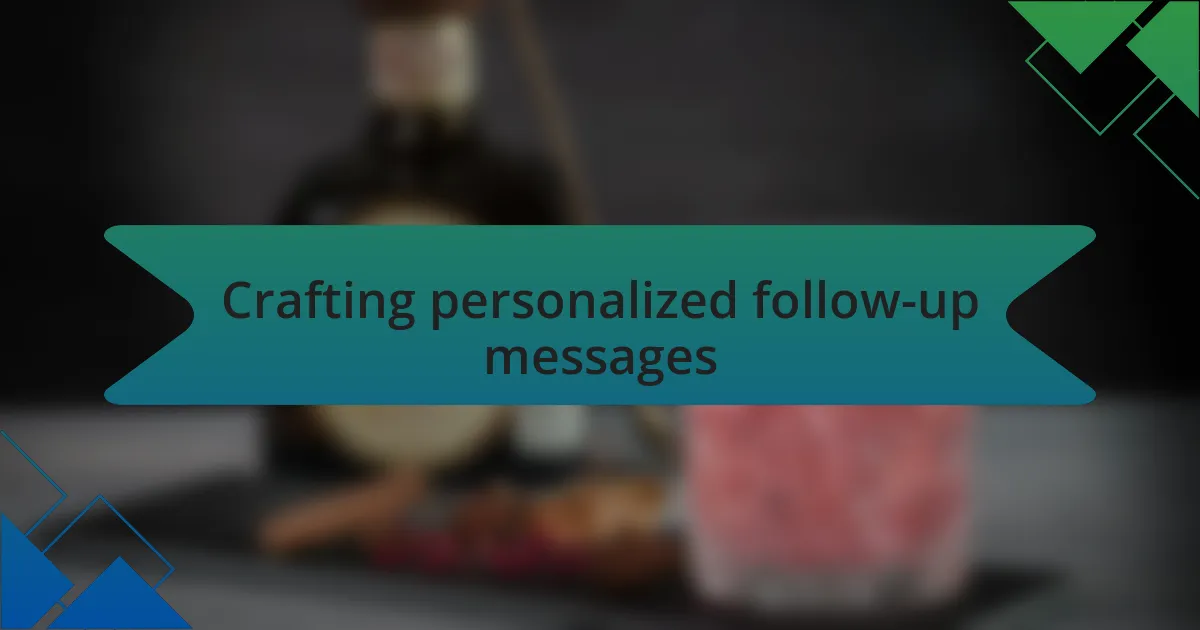
Crafting personalized follow-up messages
Crafting personalized follow-up messages can significantly elevate your connection with attendees. I remember a time when I followed up with someone who had a lot of questions about gin distillation during a tasting event. By referencing that chat and offering additional resources, I showed that I genuinely valued our conversation and was eager to assist. Doesn’t it feel great when someone remembers details about you?
In my experience, including a bit of humor or light-heartedness in these messages can also work wonders. After a quirky event with a gin cocktail competition, I sent a playful note to some participants, joking about their “creative” concoctions. That human touch not only made them chuckle but also kept the interaction enjoyable. Isn’t it astounding how a little levity can foster deeper relationships?
Lastly, I always make it a point to include a call to action in my follow-up messages. For instance, after an event, I invited folks to join a webinar on pairing gin with food, which aligned perfectly with their interests expressed during the event. This not only made the conversation relevant but also encouraged ongoing engagement. How do you usually invite your attendees to stay connected? This can shape their willingness to interact with your brand long after the event is over.
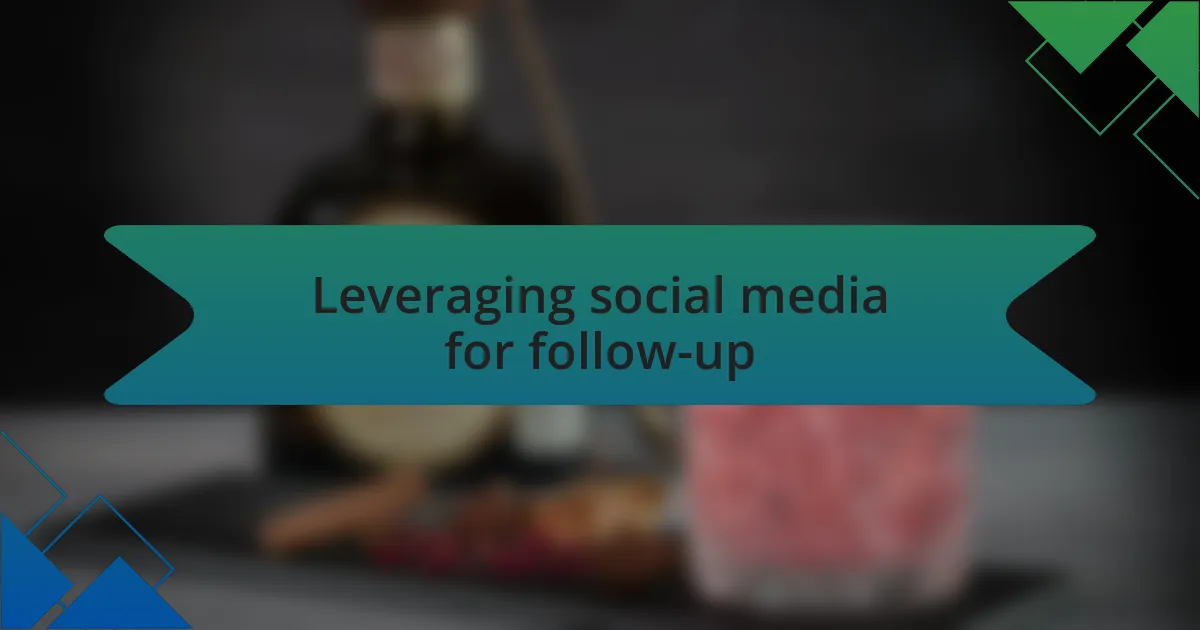
Leveraging social media for follow-up
Utilizing social media for follow-up is a powerful way to maintain relationships with event attendees. I recall using Instagram to share behind-the-scenes photos from a distillery tour shortly after an event. Tagging attendees in those posts not only made them feel included but also sparked conversations about their favorite moments. Have you considered how engaging visuals can reignite interest and foster a sense of belonging among your audience?
I also like to leverage polls or questions in my follow-up stories to gauge attendee preferences and gather feedback. After one particularly engaging gin tasting, I posted a question asking which cocktail they were excited to try next. The responses were insightful and really strengthened the community feeling, as attendees began discussing their favorite recipes in the comments. It’s fascinating how a simple question can spark such lively interaction, don’t you think?
Moreover, providing valuable content through social media after an event can position your brand as a go-to resource. I remember sharing a series of quick gin-making tips that aligned with the interests expressed by attendees. This not only kept the conversation going but also established a deeper connection with my audience, as they felt they were receiving continuous value. How do you think sharing knowledge can enhance your brand’s reputation? It’s important to remember that every interaction counts in nurturing lasting relationships.
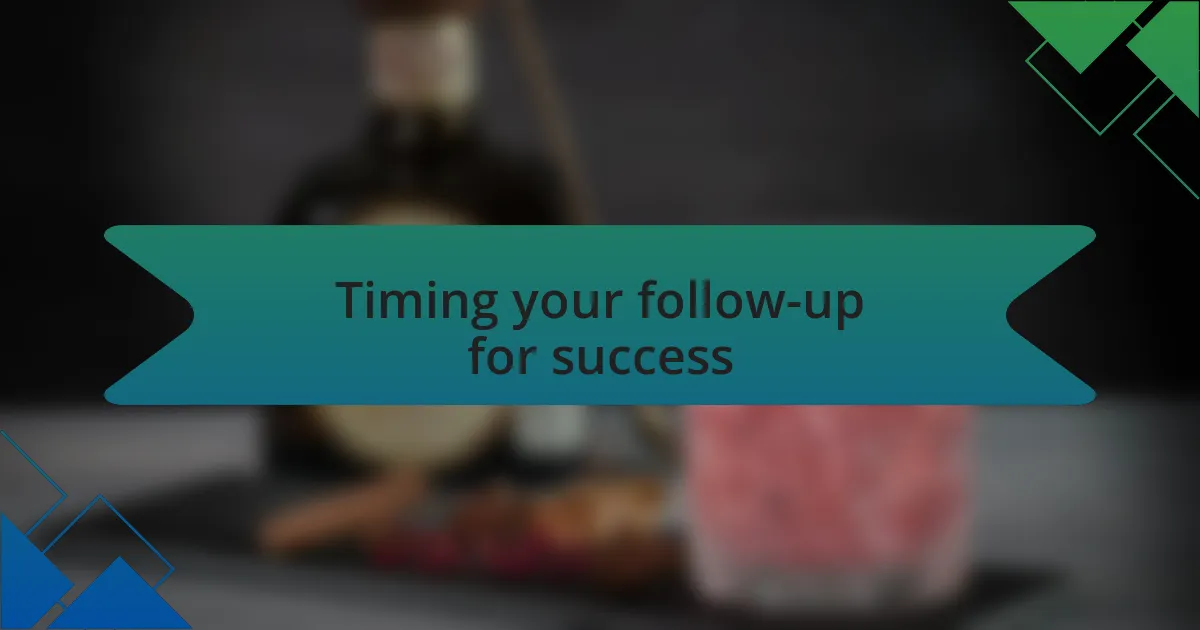
Timing your follow-up for success
Timing your follow-up is crucial for maximizing engagement and building relationships. I’ve found that reaching out within 24-48 hours post-event often yields the best responses. It’s that sweet spot when attendees are still buzzing with excitement; it feels more personal and immediate. Have you ever noticed how a timely message can reignite that spark of connection?
I remember following up with attendees of a gin cocktail workshop just days after the event. I sent personalized emails, thanking them for joining and inviting them to share their own cocktail creations. The responses were fantastic; attendees shared photos and recipes they had tried at home. It felt like I was part of their journey, and that connection was invaluable.
However, there’s also merit in timing your follow-up strategically. For instance, I’ve discovered that reaching out a few weeks later to share additional resources or upcoming events can rekindle interest and keep your brand top-of-mind. It’s all about pacing your communication, making sure you’re present without overwhelming your audience. How do you think a well-timed follow-up can influence future interactions?
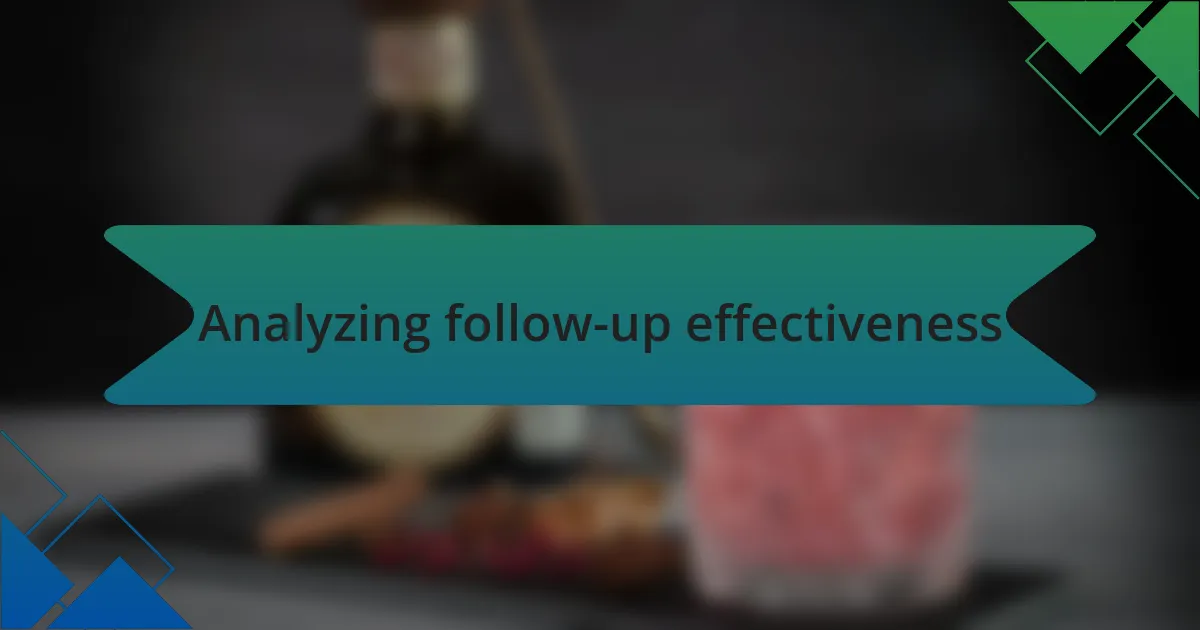
Analyzing follow-up effectiveness
Analyzing follow-up effectiveness is essential to understand how well your communication resonates with attendees. I often sift through engagement metrics, like open rates and response counts, to gauge what resonates most. For example, when I tracked a follow-up campaign for a gin tasting event, I discovered that messages featuring a personal touch led to a 30% increase in replies. Isn’t it fascinating how small adjustments can drive significant results?
I also pay attention to the sentiment in the responses I receive. After a recent event, I used feedback forms to assess attendees’ feelings about the follow-up process. Many expressed appreciation for the relatable stories I shared in my messages, reflecting on how those emotions renewed their interest in our brand. It really hit home for me—people crave connection and reassurance, don’t they?
In my experience, focusing on both qualitative and quantitative feedback makes a difference. I once implemented a follow-up survey after a gin masterclass, and the insights were eye-opening. Participants expressed a desire for deeper engagement, which prompted me to craft more interactive content moving forward. If we adapt based on this feedback, we transform our approach, ensuring that each follow-up isn’t just another email, but a meaningful continuation of a conversation. How do you currently measure the impact of your follow-ups?
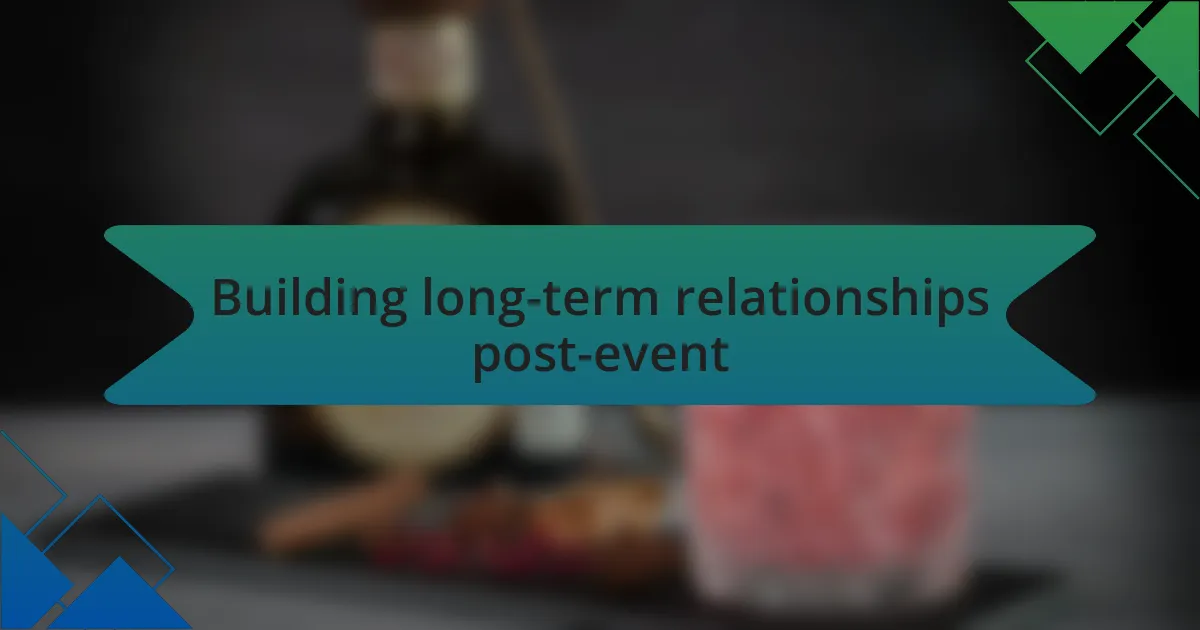
Building long-term relationships post-event
Building long-term relationships after an event hinges on consistent communication. I’ve learned that regular touchpoints help to solidify connections. After a gin festival, I began scheduling monthly newsletters filled with stories, cocktail recipes, and exclusive promotions. It was eye-opening to see how a simple commitment to sharing updates fostered loyalty among attendees.
One time, I reached out to a group of event participants a few weeks after an interactive tasting session. I asked for their feedback and offered to create a special online Q&A event tailored to their interests. The response was overwhelmingly positive; it was incredible to see people engaging in the conversation. This kind of proactive outreach makes attendees feel valued and shows that I genuinely care about their experience.
In my experience, embracing a personal touch in follow-ups is crucial. I still remember sending a handwritten note to VIP guests from an event, thanking them for their participation. Several replied, sharing their favorite moments from the evening and expressing excitement for future events. Those small gestures go a long way and remind attendees that they aren’t just a name on a list; they are individuals whose journey I’m invested in. How are you personalizing your follow-ups to strengthen those connections?